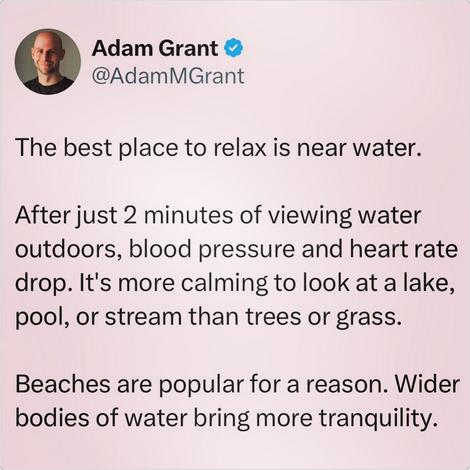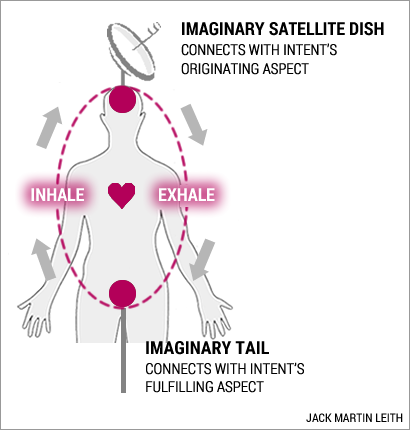
“Drifting is a special form of attention where we are engaged with the world around us but not focused on getting something done” … meaning we have left mundane world and entered either primal world or a combination of mundane and primal worlds.In the book Blue Mind, marine biologist Wallace J. Nichols states “Being near water allows us to access a semi-meditative state known as ‘drifting’. Drifting is a special form of attention where we are engaged with the world around us but not focused on getting something done.”
A study done by the University of California Davis showed that just looking at a body of water can decrease heart rate and blood pressure.
There is a reason why many of us enjoy sitting near rivers, lakes and beaches. Being near natural water is one of the powerful ways to nurture the nervous system.Reference: Richard G. Coss, Craig M. Keller, Transient decreases in blood pressure and heart rate with increased subjective level of relaxation while viewing water compared with adjacent ground | Journal of Environmental Psychology, Volume 81, 2022, 101794 | Download pdf
My source: Instagram, @scienceofessentials
When I am in London, I wake up early, walk through the woods with some other wild swimmers, and jump into the lake. During winter, with water temperatures dropping to freezing, this is nothing less than a catastrophic outrage to the nervous system and an excruciatingly intimate engagement with one’s mortality.
This encounter obliterates all anger and worldly woes. To quote Roger Deacon’s beautiful book, Waterlog, you plunge into the lake with all your raging devils and clamber out ‘a giggling idiot’. In icy water, with our adrenaline and endorphins running riot, we are returned to our innocent, primordial selves via an internal ecstatic screaming to be born defiantly afresh. We become tiny creatures in the shock of nature, and, Freya, we are made happy!
As my friends and I make our way back through the woods, borne on the wings of God’s laughing angels, in the grip of some massive dopamine surge, we understand we are better now. This sense of delight, this shivering joy, will remain with us as we go about our day.Nick Cave, on his Red Hand Files website, responding to Freya’s question “What makes you happy?” | View Nick Cave’s response in full
The newcreator’s breathing cycle
Faith — believing without believing, acting without certainty — enables the newcreator to transcend the mundane by establishing a connection with the originating and fulfilling aspects of intent (also known as spirit, source, the Tao, Creatve Action, media and Infinite Intelligence, among other names).
Before you begin, you must be in a state of faith, with all rules, norms, codes, taboos, beliefs, dogmas, narratives and ideologies packed into a suitcase and left in a locker, to be reclaimed later.
Now imagine that the top of your head is a satellite dish that receives intent’s originating aspect.Faith is a much-abused term, often derided in modern secular circles as the blind obedience to some arbitrary authority. But it has a wiser and more useful meaning: faith as a critical but curious mind’s readiness to adopt a reality model (even if provisionally) for which there is less than absolute, empirical proof.
Jay B. Gaskill, The Dialogic Imperative
View more quotes about faith
Also imagine that you have a tail that extends to the ground beneath your feet and receives intent’s fulfilling aspect.
Choose a special name for each aspect — originating and fulfilling. The names are not important as long as they’re respectful and you feel comfortable subvocalizing them.

As you slowly inhale, imagine intent’s fulfilling aspect rising from the earth, through your tail, all the way up your spine to the top of your head where the satellite dish is perched and into the atmosphere. Completely fill your lungs. While this is happening, subvocalize the special name you have chosen for this aspect.
And as you slowly exhale, imagine drawing the originating aspect down from the air around you, through the satellite dish, all the way down your spine to your tailbone, then down through the imaginary tail and into the ground. Completely empty your lungs. While this is happening, subvocalise the special name you have chosen for this aspect.
As you continue with this breathing cycle for several minutes, you may become aware of a warm radiance in your heart. This is intent, love, faith, desire or whatever word works for you.
With practice, the breathing cycle will become second nature and you will simply inhale and exhale while subvocalising the special names.
Some other ways
River Kenna outlines various ways of balancing the brain’s hemispheres in this Substack. They include the books Drawing on the Right Side of the Brain by Betty Edwards, and The Artist’s Way by Julia Cameron.
Continue reading
Search the site
Not case sensitive. Do not to hit return.